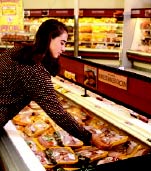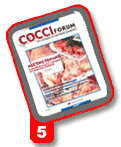Cover Story - Natural Tendencies
Mainstream poultry companies eye drug-free programs to address growing consumer demands and regulatory trends
 |
Produce healthy, competitively
priced chicken without using infeed
antibiotics, anticoccidials or
growth promoters?
What sounded pretty far-fetched
only a few years ago is steadily becoming
reality for some mainstream poultry
companies in the United States and
other major poultry markets as they
keep one eye on consumer demand
and another on regulatory trends.
Smaller producers serving niche or
specialty markets were the first to tap
into this expanding market, using the
value-added benefits of their so-called
"natural chicken" to lure increasingly
informed, health-conscious consumers
who are willing to pay a premium for
drug-free birds.
Now it appears that mainstream
companies are following suit and, in
some cases, actually launching "natural"
lines under separate brand names.
And even if they are still using
antibiotics to control some diseases,
there are signs that big players in the
industry are trying to wean themselves
from antibiotics before regulators force
them to go "cold turkey."
Scrutinizing antibiotic use
As it is, six anticoccidials were banned
in the European Union last year and all
but two growth-promoting antibiotics
are now completely off limits (see
CocciForum, No. 4). In the United
States, where many of these products
are still available, increasing regulatory
pressure could prompt some poultry
companies to reduce or eliminate some
uses of drugs from livestock and poultry
feeds.
For example, a recent piece of legislation,
proposed by Sen. Edward
Kennedy, D-Mass., aims to phase out
"the routine feeding of medically
important antibiotics to healthy farm
animals." Sen. Kennedy's bill is similar
to a House version that carries bipartisan
support as well as endorsements
from the American Medical Association
and other groups.
In December 2001, a U.S. group
called Keep Antibiotics Working "a
coalition dedicated to reducing the use
of antibiotics in animals "wrote to 50
poultry producers to advise them of
three studies published in October in
the New England Journal of Medicine,
which attempted to show links
between antibiotic overuse and drugresistant
bacteria found in meat and
poultry products.
The coalition "which includes the
Union of Concerned Scientists, Environmental
Defense, the Center for
Science in the Public Interest and the
Natural Resources Defense Council -
then asked each poultry company to
"commit to eliminating the nontherapeutic
use of medically important
antibiotics in your production practices"
and surveyed them about their antibiotic usage. The results of this survey
have not yet been reported.
These types of pressures in the
press and from consumer organizations
are causing many producers to re-evaluate
their current practices.
What's Natural and What's Not?What exactly is "natural chicken" anyway? As is the case with other similar terms, like "organic" and "free-range," it depends on whom you ask. "There has been little or no headway made toward a uniform definition of what 'natural' really means," says Yvonne Thaxton, editor of Poultry magazine. According to USDA, the natural chicken label means "no artificial ingredients or colors were added, and that it was minimally processed." But what, then, does "artificial" mean? And what about "minimally processed" ? Right now there are a lot more questions on this topic than there are definitive answers. |
Filling the void
To fill the potential void left by antibiotics,
some mainstream poultry companies
are putting more emphasis on vaccines
and other biological or natural
controls. And, according to some
reports, they appear to be making
those strategies work "without experiencing
big increases in production
costs.
Mainstream poultry companies contacted
by CocciForum understandably
declined to comment on their marketing
plans for "natural" chicken or what
they were doing to combat disease
without the usual arsenal of feed antibiotics
and anticoccidials. It is, after all, a
highly competitive industry. Even so, in
talking with industry people, it seems
that major producers are definitely
moving in the less-drugs-is-better direction.
Yvonne Thaxton, executive editor
of Poultry "a magazine serving the
packing and food-processing industries
"says recent announcements by
Tyson, Foster Farms and Perdue that
they would eliminate use of some types
of antibiotics will likely accelerate the
movement toward more drug-free
poultry.
"Like it or not," Thaxton wrote in a
recent column, "there are a lot of people
who still believe that chicken are
routinely fed antibiotics and hormones"
in their starter and grower feeds, and so
they don't eat poultry. "Anything that
poultry producers can do to change
that perception will help attract more
consumers."
In an article last February about
poultry companies shying away from
antibiotics, The New York Times told its
readers, "Treating a few sick birds [with
antibiotics] requires treating the entire
flock, and flocks often number more
than 30,000. The only way for consumers
to be certain the chickens they
buy have not been treated with antibiotics
is to purchase those labeled
antibiotic-free, or organic."
The article went on to report that
some corporate consumers, including
the high-volume fast-food chains
McDonald's, Wendy's and Popeye's, are
now refusing to buy chicken that has
been treated with certain antibiotics.
Carving a bigger niche
Natural foods of all kinds are riding a
wave of popularity worldwide. Organic
foods are an example. Says Thaxton,
"Although in percentage terms, organic
remains a tiny fraction of the market, it
is a growth area with tremendous loyalty
among its core customers."
But, besides a simple preference for
more natural foods, there are a number
of other factors linked to increased
consumer demand for more drug-free
chicken and other meats.
One is the U.S. economy, which,
until recently, was booming. "Because
we went through a rather affluent
time," says Susan Dosier, executive editor
for foods and entertaining at
Southern Living magazine, "many people
had the economic means to be
more selective in their food, health and
lifestyle choices."
No one is willing to predict, with
any assurance anyway, how the current
economic slowdown is going to affect
sales of more drug-free chicken in the
coming months and years, but industry
trend-watchers say they see little sign
of it slowing.
Another significant factor fueling
growth in so-called natural chicken has
been greater awareness of these issues
by consumers. "The impact of the
Internet has been huge [on consumer
decision-making]," says Rod Smith, a
veteran tracker of industry trends and
staff editor for Feedstuffs, a weekly business
journal for agribusiness.
"Consumers tapping away on their
laptop computers are accessing a lot of
information that they never had before,
including information about the ways
their food is produced," he adds. "True,
a lot of it is from sources that may not
always be legitimate. But the information
is powerful nonetheless."
Powerful, indeed.
A survey conducted by Prevention
magazine found that 51% of U.S. consumers
would like to buy "organic"
meat and poultry if it were labeled as
such, and 35% of those people said
they would be willing to pay more for
those products.
Good housekeeping
In order to reduce or eliminate antibiotics
from their flocks, the major companies
are relying on a wide array of
tactics. One of those is improving ventilation
in housing areas.
"Inadequate ventilation is the source
of many health problems," says Poultry
magazine's Thaxton. "As farms keep litter
for more flocks, ammonia levels
increase and flock health can be compromised."
Improved ventilation can correct
much of this problem, she points out.
"But increased ventilation can cost
growers more money to heat the housing
areas during cold months," she adds.
Cooling systems are also drawing
more attention as producers try to
reduce disease pressure. "The bigger
birds grown for today's markets must
be adequately cooled to get the best
performance," says Dr. Danny L.
Magee, clinical professor of avian medicine
at Mississippi State University.
"This requires better and more efficient
cooling systems."
Effective rodent control is another
important area that health-conscious
growers have to watch. Dr. Hashim
Ghori, director of the poultry disease
program at the Arkansas Livestock and
Poultry Commission, Little Rock, stresses
that rodent control is essential in
raising healthy birds "with or without
antibiotics.
"It's an imperative component in
any good housekeeping program," he
says. "Rodents are, of course, big carriers
of Salmonella and other harmful
bacteria. Smart growers are making
effective rodent control a top priority."
Another aspect of good housekeeping
is collecting dead birds from the
housing area as soon as possible, Ghori
says.
"In a flock of several thousand
birds, it's inevitable there are going to
be a few birds that don't survive for
one reason or another," he adds. "To
help cut down on transmission of
harmful bacteria, it's important that
growers make sure those birds are
picked up on a regular basis."
Vaccination a key component
Vaccination, against coccidiosis and
other diseases, is one of the most effective
tools growers are using to reduce
usage of antibiotics and other drugs.
Dr. Bruce Stewart-Brown, director
of health services at Perdue Farms,
Salisbury, Md., says his company works
hard to breed birds and use practices
that will help the birds ward off infection
in a natural way.
"Vaccines play a very strong part in
our plan to prevent disease," he says.
"We've always had the strong philosophy
that vaccination and disease prevention
should be 99.9% of our focus.
Our programs are meant to prevent illness.
And when we have a problem
with a particular flock, we take it very
seriously. We look to see if we have a
weakness in our system that needs to
be analyzed. We spend a lot of time
with disease prevention and monitoring."
Arkansas' Ghori agrees that vaccination
plays a pivotal role in raising
healthy birds for both mainstream and
specialty-market poultry companies.
"Vaccines are a very effective way to
help chickens develop the resistance
they need to withstand challenge by
pathogens they encounter in the environment,"
he says. "They're a key component."
 Ghori: '"�vaccination plays a
pivotal role in raising healthy
birds for both mainstream and
specialty-market poultry
companies.'
|
Keeping coccidiosis in check
Coccidiosis control is one area where
mainstream poultry companies are successfully
trading in traditional in-feed
anticoccidials for vaccines. Coccidiosis
vaccination is allowing them to reduce
or eliminate some drugs from their
health programs.
According to Schering-Plough
Animal Health Corporation, a company
that markets two lines of coccidiosis
vaccines, seven of the top 10 poultry
companies in the United States now
vaccinate at least a portion of their
birds for coccidiosis.
For example:
"� For the past 5 years, Townsends of
Batesville, Ark., has been vaccinating
its broilers for coccidiosis from late
spring to early fall. In-feed anticoccidials
are used in the other cycles. "It's
more economical to vaccinate than it is
to add coccidiostats to the feed," says
hatchery manager Dave Kohler. (See
CocciForum, Issue No. 4.)
"� Peco Foods of Sebastopol, Miss., has
been vaccinating for coccidiosis since
1998. "With the new spray cabinet technology,
the vaccine is distributed uniformly
and we're getting excellent control
"as good or better than what
we've had with any in-feed product,"
says live production manager Van
Bowman. He adds, "Because the vaccine
protects against coccidiosis for the
lifetime of the bird [as opposed to a
limited treatment period by programs
using in-feed anticoccidials], I don't
have to worry about birds breaking
with disease as they get older." (See
CocciForum, Issue No. 2.)
The trend is also catching fire overseas.
As reported in a previous issue of
CocciForum (No. 1), southeast Asian
poultry giant Charoen Pokphand,
Bangkok, found vaccinating for coccidiosis
to be an effective way to
reduce drug use in its flocks.
Somboon Denvanich, a senior vice
president for the company, says CP's
resellers "wanted a strategy for adding
value to their products." He adds,
"Drug-free birds are helping our
resellers reach that goal and obtain a
premium price on their products."
Measuring returns
But what about the costs-versus-profit
of raising birds using a coccidiosis vaccine
rather than routine use of drugs?
In the case of CP, Denvanich says
that finishing time for a 2-kilo (4.4 lb)
vaccine-only bird is about 45 days -
about 3 days more than when the company
uses growth-promoting antibiotics
such as zinc bacitracin and virginiamycin,
and other feed antibiotics.
"Overall our production costs are up
about 10%," he says, "but we're getting
about a 15% premium" on the vaccineonly
birds.
Results of studies comparing vaccinated
birds with those receiving in-feed
coccidiostats support the real-world
experience reported by CP and others.
In one series of studies conducted by
Dr. Harry Danforth of USDA, weight
gain and feed efficiency in vaccinated
birds initially lagged behind those fed
anticoccidials. However, the vaccinated
birds eventually caught up and, by the
end of the study, there was no statistically
significant difference in weight or
feed efficiency between the two
groups, which were grown 53 to 63
days.1 Similar results have been
obtained in studies with broilers.
Still, a number of important questions
remain. One is whether the
demand for drug-free poultry is a growing
trend or just a passing fad. Another
is exactly how much growers can rely
on vaccines and good housekeeping
practices alone to keep their flocks
healthy without in-feed drugs. And still
another: What sort of profits can growers
reap "over the long term as well
as the short term "from raising drugfree
or so-called natural birds?
Those are questions that are likely
to be answered sooner rather than later
by producers working hard to expand
this once regarded "niche" market into
a major one.
As Poultry's Thaxton puts it,
"Looking for creative ways to increase
consumption both locally and internationally
sometimes means looking for
big opportunities in smaller places."







